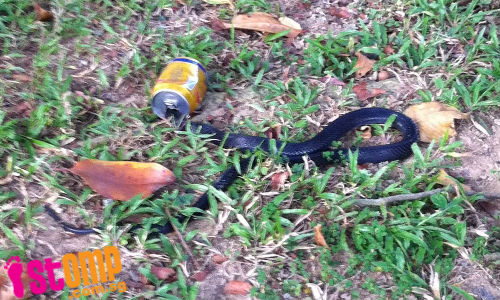
STOMPer ZhaoYong was one of the many who gathered around this black snake that had gotten its head stuck in a can of Red Bull on a grass patch near Block 25 in Marsiling Drive.
The STOMPer wrote:
"This snake was spotted at the void deck of Marsiling Drive Block 25 near the bus stop.
"It's kind of small.
"But the stupid snake's head got stuck inside a red bull can.
"The police have arrived and the crowd is building up."
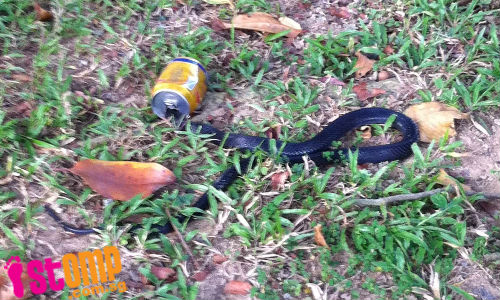
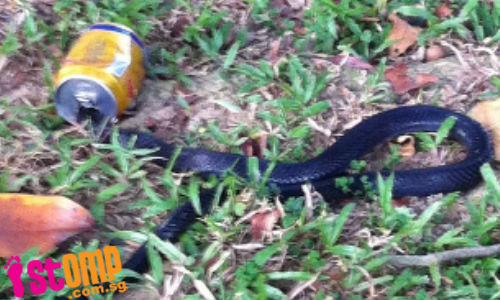


Note: Goondu is a Singlish term that means idiotic.
This post goes to show just how the trash we produce and the litter discarded so irresponsibly can have a severe impact on wildlife. The snake pictured is an equatorial spitting cobra (Naja sumatrana), a species that is relatively common in Singapore. If it had truly gotten its head stuck in the drink can, I hope it was eventually captured and safely released elsewhere. While cobras do pose a risk to people, incidents of people getting attacked appear to be rare, even though the species is widespread and regularly seen, even in gardens and urban areas.
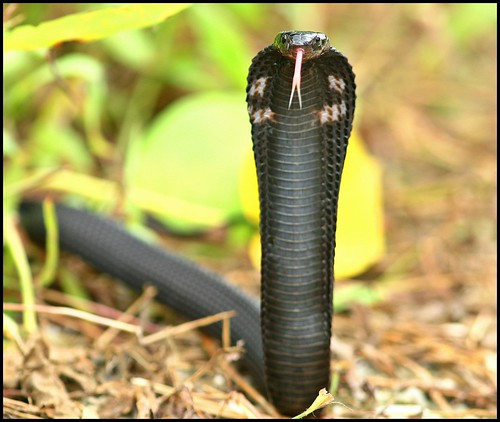
Khatib Bongsu;
(Photo by hiker1974)
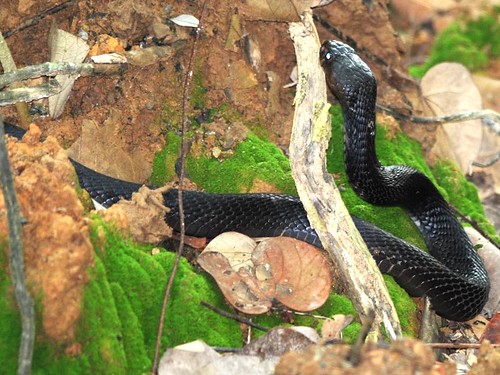
Pulau Ubin;
(Photo by kokhuitan)
I've had a couple of encounters with equatorial spitting cobras myself; my first sighting of a live cobra was on Pulau Ubin, with Ria and Chay Hoon.
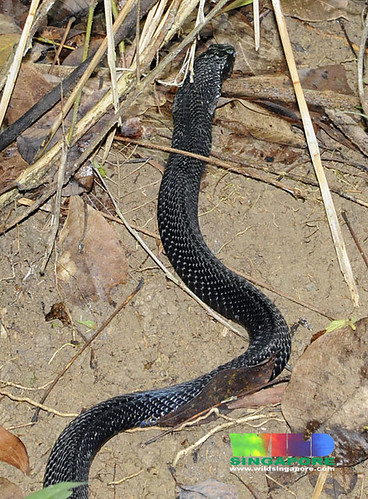
Pulau Ubin;
(Photo by Ria)
And earlier this year, I was with Nikita Hengbok when we saw a cobra behind Tanah Merah MRT Station.
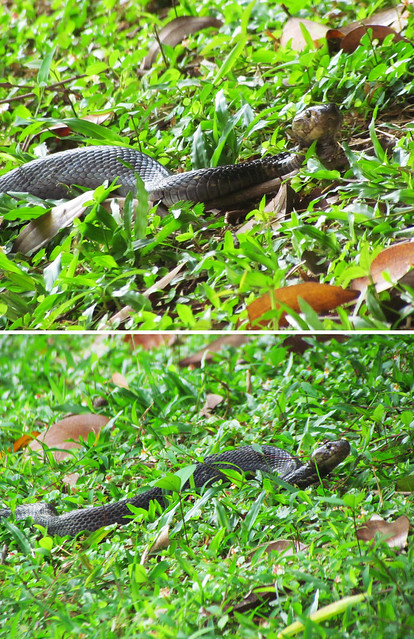 ">
">Tanah Merah;
(Photo by Niki)
A recent hike along the KTM railway tracks turned up the carcass of a cobra which had apparently been sliced in half, presumably by a passing train. This was in Woodlands, close to the mangroves of Sungei Mandai Besar.
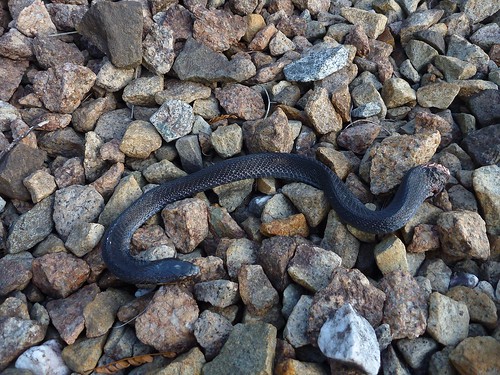
The Animal Concerns Research and Education Society (ACRES) Wildlife Rescue team frequently responds to calls to relocate cobras found in urban areas. These are quickly caught and released in a safe location, far from people.

Adnoh had taken refuge inside a motorcycle;

Run-of-the-mill was found in a HDB neighbourhood, close to a lift landing;

Kermit was spotted by a cleaner behind a childcare centre, and restrained by a broom until the Wildlife Rescue team arrived;

Raisin was removed from a school;
(Photos from ACRES Facebook page)
However, a number of cobras are killed by people who are afraid of the risks and possibility that the snake will escape before professional help arrives.


(Photos from ACRES Facebook Page)
This species is found from southern Thailand and Peninsular Malaysia to Sumatra and Borneo, as well as Palawan and the Calamian group of islands in the Philippines. Interestingly enough, while the equatorial spitting cobras we find in Singapore and the southern part of Peninsular Malaysia are black, those from Thailand tend to be yellowish or light brown.
For example, compare this equatorial spitting cobra, which was photographed in Malacca:

(Photo by Sky and Yak)
...With this other equatorial spitting cobra, which is a captive that is presumably of Thai origin:

(Photo by Venom Street)
The equatorial spitting cobra is so named because it is one of several cobra species capable of spraying venom from its fangs. All cobra species can rear up and flare out the hood to intimidate and drive away potential predators, but the various species of spitting cobra take this threat display a step further, squirting venom so as to reinforce the idea that this snake is not to be trifled with.
This is illustrated here with a Mozambique spitting cobra (Naja mossambica), a species from Africa.
Muscles around the venom glands contract, squeezing them and forcing venom at high-pressure through the fangs. The droplets of venom are useless if they land on skin; it has to enter the bloodstream for the toxins to take effect. So the cobra actually aims for the eyes, tracking and synchronising the movements of its head to match the movement of the predator's face. The cobra is able to aim at this moving target with deadly accuracy, anticipate where the predator's face is going to be, and then makes split-second adjustments so that the trajectory of its spray has a high chance of hitting the eyes. The cobra may also wiggle its head from side to side, spreading its venom over a wider area. Under certain circumstances (e.g. large individual, speed of venom jets as they exit the fang, wind direction and speed), a spitting cobra may be able to hit its target from a distance of 3 metres!
Once the venom manages to enter the eyes, it causes great pain, inflammation of the cornea and conjunctiva, and temporary blindness. If the venom is not washed out promptly, the venom may cause further damage to the cornea, resulting in permanent loss of sight. A spitting cobra is capable of spitting repeatedly in quick succession, and still have enough venom to deliver a final bite, if the previous warnings were not heeded. In this way, the spitting cobra manages to warn potential predators about its deadly venom and its willingness to use it, while discouraging them from getting too close. After all, a snake's striking range is limited, and a predator that approaches close enough to get bitten may still be capable of injuring or killing the cobra.
The bite of a cobra may be fatal, with the venom containing neurotoxins that affect the nervous system and lead to paralysis, as well as cytotoxins, which break down tissues, and haemotoxins which destroy blood cells, causing them to rupture. Venom varies from species to species, so antivenin manufactured to counteract the venom of a particular species of cobra may have limited usefulness to a victim of a bite from another species of cobra. Here in Singapore, where there is only 1 species of cobra*, this is not a major problem. However, in other parts of Asia, where more than 1 species of cobra may occur within the same area, being able to identify the species that bit you can mean the difference between life and death.
*The king cobra (Ophiophagus hannah) is also present in Singapore, but it belongs to a different genus from the 'true' cobras, which make up the genus Naja. Hence, when I say that there is only 1 species of cobra in Singapore, I am referring to cobras in the strictest sense.
Coming soon: more about cobras and other venomous snakes.